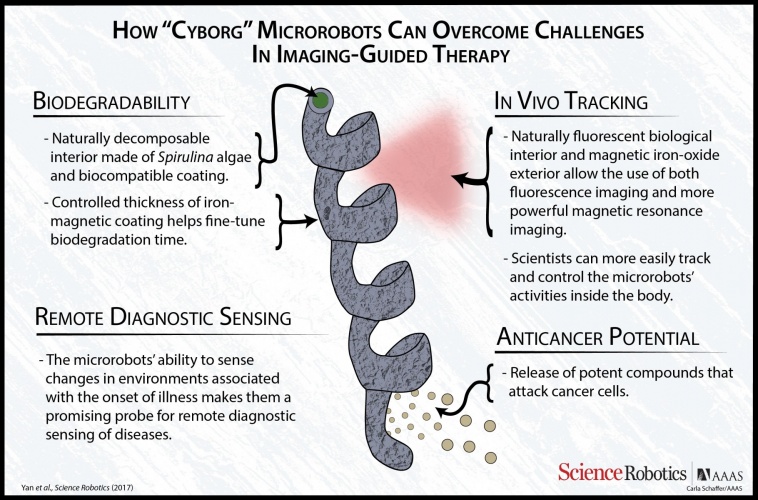
The team led by Prof Li Zhang from the Chinese University of Hong Kong, including Prof Kostas Kostarelos from Manchester University, have created the bots from a biodegradable material called spirulina algae.
A paper by the team, published in Science Robotics, hails the bots’ biodegradability as a new concept, in which an iron magnetic coating help to fine-tune the rate which they degrade.
In tests, a swarm of nanobots measuring a few millionths of a metre long were guided magnetically to sites in the stomach of rats.
They could be tracked in tissue close to the skin's surface by imaging the algae's natural luminescence, and in hard-to-reach deeper tissue by magnetic resonance imaging (MRI).
Scientists suggest their findings could lead to a way to deliver drugs to parts of the body that are otherwise difficult to treat. The nanobots could also sense chemical changes linked to the onset of illness within parts of the body, which makes them potentially useful as probes for remote diagnosis.
The time taken for the robots to function and biodegrade within the body could be tailored by adjusting the thickness of their manufactured coating.
In lab tests, the devices were found to release potent compounds from the algae core during degradation, which selectively attacked cancer cells while leaving healthy cells unharmed. Further research could show whether this might have potential as a treatment, researchers say.
The team cautions that more work needs to be done on motion tracking, biocompatibility, biodegradation, and diagnostic and therapeutic effects before clinical trials can take place.
Professor Zhang said: “Rather than fabricate a functional microrobot from scratch using intricate laboratory techniques and processes, we set out to directly engineer smart materials in nature, which are endowed with favourable functionalities for medical applications owing to their intrinsic chemical composition. For instance, because these biohybrid bots have a naturally fluorescent biological interior and magnetic iron-oxide exterior, we can track and actuate a swarm of those agents inside the body quite easily using fluorescence imaging and magnetic resonance imaging.
“Our microrobots have the ability to sense changes in environments associated with the onset of illness and that makes them a promising probe for remote diagnostic sensing of diseases.
“We must now develop this technology further so we are able to fine-tune this image-guided therapy and create a proof of concept for the engineering of multifunctional microrobotic and nanorobotic devices.”
Professor Kostarelos said: “Creating robotic systems which can be propelled and guided in the body has been and still is a holy grail in the field of delivery system engineering.
“Our work takes advantage of some elements offered by nature such as fluorescence, degradability, shape.
“But we add engineered features such as magnetisation and biological activity to come up with the proof-of-concept behind our bio-hybrid, magnetically propelled microrobots.
He added: “We are still in early days of development since any such robotic system would need to be either completely and safely degraded, or it will need to be removed or excreted from the body after it has finished its work.
“But nevertheless, our work provides the first ever example of how this could be possibly achieved by degradation.”
The research team included the Chinese University of Hong Kong, The University of Edinburgh and The University of Manchester.
The paper ‘Multifunctional biohybrid magnetite microrobots for imaging-guided therapy’ is published in Science Robotics (DOI: 10.1126/scirobotics.aaq1155) on 22 November 2017.





Swiss geoengineering start-up targets methane removal
No mention whatsoever about the effect of increased methane levels/iron chloride in the ocean on the pH and chemical properties of the ocean - are we...